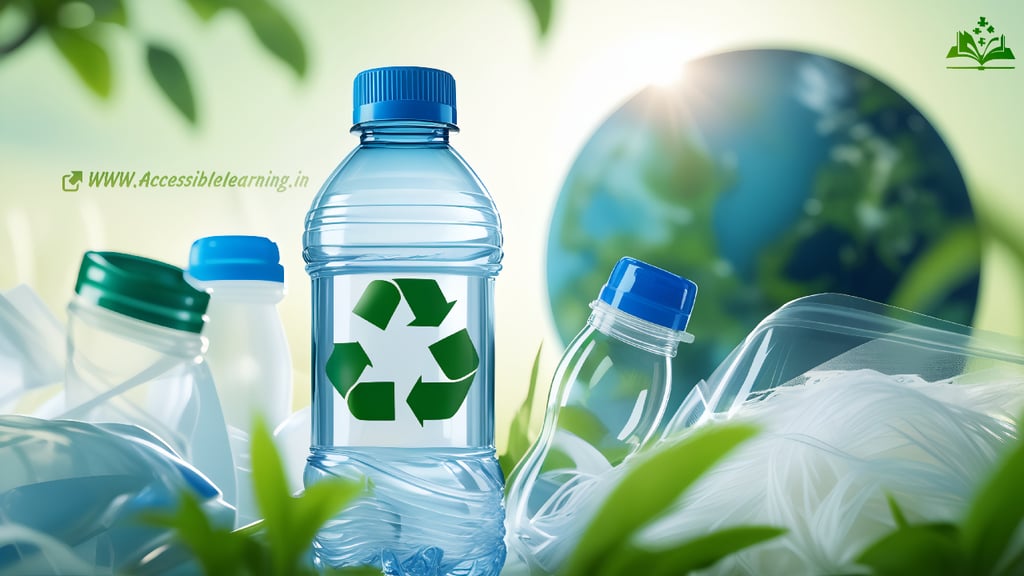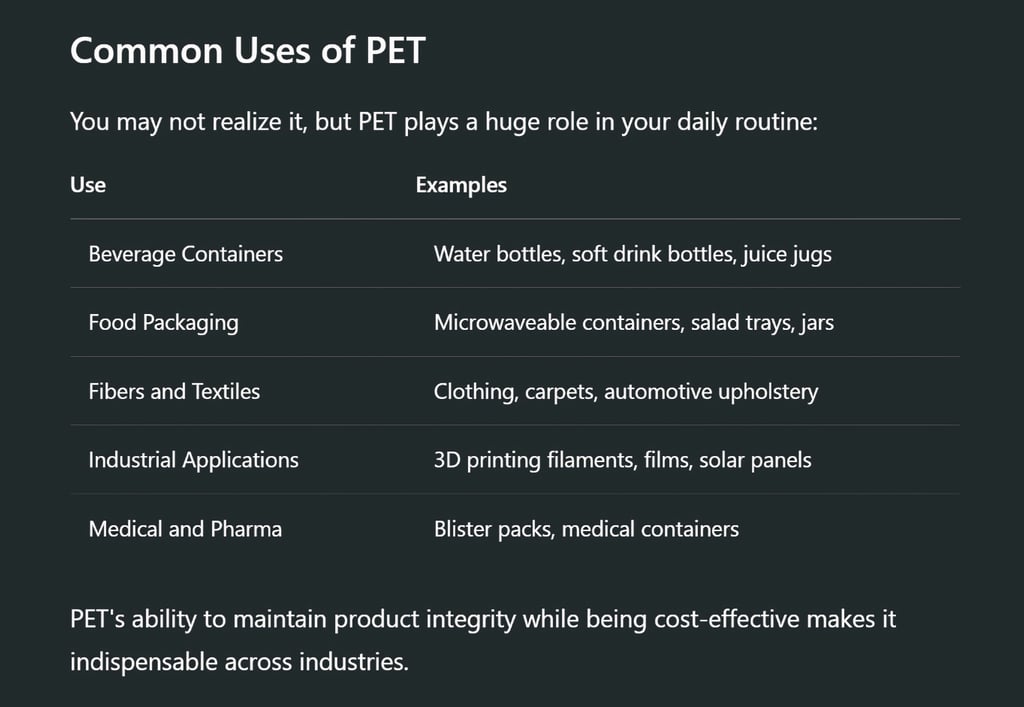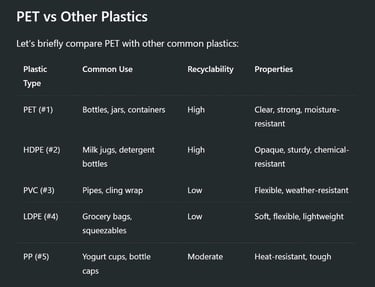
What Is PET Plastic and Why Does It Matter?
Discover everything about polyethylene terephthalate (PET) plastic—its properties, everyday uses, recyclability, environmental impact, and future innovations. Learn why PET is a cornerstone of modern sustainable packaging.
ENVIRONMENTGLOBAL ISSUESEDUCATION/KNOWLEDGE
---
4/25/20254 min read


In today’s world of convenience, we often take for granted the materials that make our everyday lives smoother. One such unsung hero is Polyethylene Terephthalate, commonly known as PET. From your favorite soda bottles to microwave-safe containers, PET plastic is everywhere—and for good reason.
But what exactly is PET, why is it so popular, and what does it mean for our environment and future? Let’s dive deep into the world of this versatile polymer.
What Is PET Plastic?
Polyethylene Terephthalate (PET) is a type of thermoplastic polymer resin belonging to the polyester family. It is made by combining two monomers: purified terephthalic acid (PTA) and monoethylene glycol (MEG).
Its key characteristics include:
Lightweight yet strong
Transparent and glossy
Highly resistant to impact, moisture, and gas
Easily molded into different shapes
Thanks to these properties, PET has become the go-to material for packaging beverages, food, pharmaceuticals, cosmetics, and household products.
A Quick History of PET
PET was first synthesized in the 1940s by DuPont scientists, primarily for making synthetic fibers. In the 1970s, PET’s use expanded into bottle manufacturing, transforming the beverage and packaging industries forever. Its ability to hold carbonation made it perfect for soft drinks, and soon, its clarity and strength made it popular for juices, water, and even beer.




Why Is PET So Popular?
Safety & Durability
PET is FDA-approved for food contact and is shatter-resistant, making it safer than glass in many situations.
Lightweight
PET packaging reduces transportation costs and energy usage, which is especially important in supply chains.
Clarity
Its glass-like transparency helps showcase products, which is great for marketing and shelf appeal.
Recyclability
One of PET’s standout features is that it’s 100% recyclable. It can be turned into new containers, fibers for clothing, automotive parts, and even construction materials.
Barrier Properties
PET has excellent barrier qualities that help in protecting contents from oxygen and moisture. This extends shelf life and preserves flavor and quality.
Cost Efficiency
Its production is cost-effective due to well-established global supply chains and manufacturing processes, making it accessible for businesses of all sizes.
The Recycling Loop: PET's Environmental Advantage
Unlike some plastics that degrade in quality after recycling, PET can be recycled multiple times with minimal loss of quality. This makes it a key player in the circular economy.
How PET Recycling Works
Collection: Bottles and containers are gathered via curbside programs or deposit return schemes.
Sorting: Items are separated by resin type and color.
Cleaning & Shredding: Contaminants are removed, and PET is chopped into flakes.
Pelletizing: Flakes are melted and reshaped into pellets.
Re-manufacturing: Pellets are used to create new products.
Some countries, like Germany and Norway, have achieved 90%+ recycling rates for PET bottles through efficient deposit systems.
Recycled PET (R-PET)
Recycled PET is gaining popularity across industries. Many fashion brands now create sustainable clothing lines using R-PET fibers. Additionally, food-grade R-PET is used in packaging to help reduce environmental impact. Major companies, such as Coca-Cola and Nestlé, are increasingly incorporating R-PET into their supply chains to meet eco-conscious goals.
Environmental Concerns and Solutions
Despite its recyclability, PET is still a plastic, and its misuse or improper disposal poses environmental risks. Here are some challenges and solutions:
Concerns
Litter and ocean pollution
Long decomposition period (up to 450 years)
Microplastics from fiber breakdown
Solutions
Boosting recycling infrastructure
Promoting R-PET (recycled PET) in manufacturing
Encouraging consumers to reduce single-use plastics
Innovations in biodegradable PET alternatives
Raising awareness about proper sorting and recycling practices


FAQs
Is PET plastic safe for food and beverage use?
Yes, PET is FDA-approved for food and beverage contact. It is non-toxic, shatter-resistant, and does not leach harmful chemicals when used properly.
Can PET plastic be recycled more than once?
Absolutely. PET can be recycled multiple times into new containers, fibers, and other products with minimal loss of quality, making it a sustainable plastic option.
What is the difference between PET and other plastics?
PET is known for its strength, clarity, and recyclability. Unlike PVC or LDPE, PET is more widely accepted in recycling programs and is often used for beverage bottles and food containers.
How long does PET plastic take to decompose?
If not recycled, PET plastic can take up to 450 years to decompose in the environment. That's why proper recycling and reuse are crucial.
What is R-PET?
R-PET stands for Recycled Polyethylene Terephthalate. It’s made by processing used PET plastics into new, usable materials—commonly found in packaging, textiles, and sustainable products.
Is PET plastic biodegradable?
Traditional PET is not biodegradable. However, research is ongoing into bio-based and enzyme-degradable PET variants that could offer more eco-friendly options in the future.
What are some brands using R-PET today?
Major global brands like Coca-Cola, PepsiCo, Adidas, and H&M are increasingly using R-PET in their packaging and products as part of their sustainability initiatives.
The Future of PET Plastic
The future of PET lies in innovation and responsible use. Researchers are working on bio-based PET made from renewable resources, as well as enzymatic recycling methods that break PET down into its base monomers, allowing for true closed-loop recycling.
Bioplastics and PET
There is growing interest in plant-based PET, which is chemically identical to petroleum-based PET but derived from sources like sugarcane or corn. These bioplastics reduce reliance on fossil fuels and can integrate into existing recycling streams.
Global Trends
Governments and industries are increasingly introducing extended producer responsibility (EPR) schemes, requiring manufacturers to manage the lifecycle of their products, including PET packaging. This could lead to more innovation, better design for recyclability, and higher recycling rates.
Companies are also committing to using more R-PET in their packaging, reducing virgin plastic production. As consumer demand for sustainable products grows, the shift toward eco-friendly PET alternatives is accelerating.
Polyethylene Terephthalate (PET) is more than just a plastic—it's a pillar of modern convenience and sustainability. While it comes with its challenges, when used and managed responsibly, PET offers a balance between functionality and environmental mindfulness.
Next time you reach for that clear water bottle or a pre-packed salad, take a moment to appreciate the science and effort behind the humble PET plastic. It’s shaping not only our products but also our planet’s future.
Subscribe To Our Newsletter
All © Copyright reserved by Accessible-Learning Hub
| Terms & Conditions
Knowledge is power. Learn with Us. 📚


